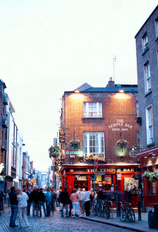Author: vagabondginger
Date of Trip: November 2013
Copper Canyon Trip Nov 23-29, 2013 by Ginger
This bus trip leaves from Phoenix or Tucson and is escorted by a bi-lingual tour director. We crossed into the Mexican State of Sonora at Nogales, had lunch in Santa Ana and stopped in Hermosillo to see the lovely colonial cathedral. Our first night was spent at the Marinaterra Hotel in San Carlos at the Sea of Cortez with rooms and restaurant overlooking the water.
The next morning we boarded a boat to go out on the Sea of Cortez. A humpback whale was spotted and we were able to close in for good looks as it surfaced a few times. The blue footed booby birds were dive bombing the water, but we got a close look at them too up on the rocks. And many dolphins were frolicking in our wake.
Next we wandered thru a massive cacti garden of saguaro, organ pipe and cardon, which are the largest cactuses in the world and only found in the Sonoran Desert. We also learned about pearl oyster farming in this area before departing from the sea.
Then it was on to the historic town of Alamos. We strolled the cobblestone streets and visited some of the restored Spanish colonial mansions with central courtyards that were built when Alamos’ silver mines were the richest in the world. The hotel was an old convent so although the rooms were a bit sparse, each had it’s own charming decor. A mariachi band and folkloric performances entertained us in the evening.
The following day we moved onto the Sinaloa State of Mexico to the town of El Fuerte where we stayed at the Torres Mansion which was a 200 year old restored hacienda with a beautiful Moroccan decor. Because we were in a group we were able to tour each others uniquely different rooms, each was eclectic yet elegant. After a dinner of fresh black bass from the river, we were entertained by Spanish dancers and a Yaqui tribe deer dancer.
The following morning we boarded the El Chepe train in El Fuerte to the Posada Barrancas stop, winding thru tunnels and across bridges. It took almost 100 years to lay railroad track in this rugged terrain, making this “Train in the Sky” one of the most exciting train journeys in the world. It goes from sea level to 8,000 ft in 150 miles. Barranca del Cobre or The Copper Canyon is actually several canyons and it’s gigantic gorges are larger and deeper than the Grand Canyon, but it is different as it is more verdant. Although there was some mining done here, it’s name comes from the copper/green colors of the canyon walls.
Our castle style hotel for 2 nights was near the rim of the deepest Urique canyon and we are now in the Chihuahua State of Mexico. The Tarahumara live in cave dwellings in the cliffs and they are the 2nd largest indigenous group in North America after the Navajo. They call themselves Rapanuri which means foot runners and they are known for their long distance running thru the steep canyons. They will run down prey or just race kicking a ball as a game.
The women mostly sell baskets they weave and the men do wood carvings. We visited a local medicine woman, hiked down to the cave dwellings, and visited their markets making it a true cultural experience.
We also took the new aerial tram across the canyon. Then it was back on the bus and we went across the Divisadero (Continental Divide) to the town of Creel and then on to Casas Grandes in the Chihuahuan desert where we spent the night.
Years ago Mormons settled here to escape the polygamy laws in the U.S and although many returned to the U.S. during the Mexican Revolution, there is still a Mormon settlement here. Mitt Romney’s father was born here and he has many cousins living here today.
The famous Mata Ortiz pottery is created here. Each piece is fully handmade by local artisans from digging up the clay from the surrounding lands to the finished product. They do not use a pottery wheel but instead start with a small bowl mold and then use the coil method to build up the walls. They polish them using stones & bones and the designs are hand painted with brushes using their own hair. To fire the pots, they put them on a layer of sand on the ground, cover with a metal pan, stack wood around it and light with kerosene. Their work is found in museums around the world and is highly prized by collectors, often selling for hundreds of dollars.
Just outside Casas Grandes is the UNESCO World Heritage Site of the archeological ruins of Paquime. This 800 year old settlement was abandoned in 1450AD. The modern pottery made today is fashioned after artifacts found here.
This was a 7 day trip that can be booked at www.trafalgar.com or www.acloserlooktours.com or www.affordabletours.com
We hand-pick everything we recommend and select items through testing and reviews. Some products are sent to us free of charge with no incentive to offer a favorable review. We offer our unbiased opinions and do not accept compensation to review products. All items are in stock and prices are accurate at the time of publication. If you buy something through our links, we may earn a commission.
Related
Top Fares From
Today's Top Travel Deals
Brought to you by ShermansTravel
Japan: 10-Night Kanazawa Tour, Incl. Kenrokuen...
smarTours - JNTO
 vacation
$4320+
vacation
$4320+
London to Reykjavik: Luxe, 10-Night Northern...
Regent Seven Seas Cruises
 cruise
$8175+
cruise
$8175+
Ohio: Daily Car Rentals from Cincinnati
85OFF.com
 Car Rental
$19+
Car Rental
$19+



